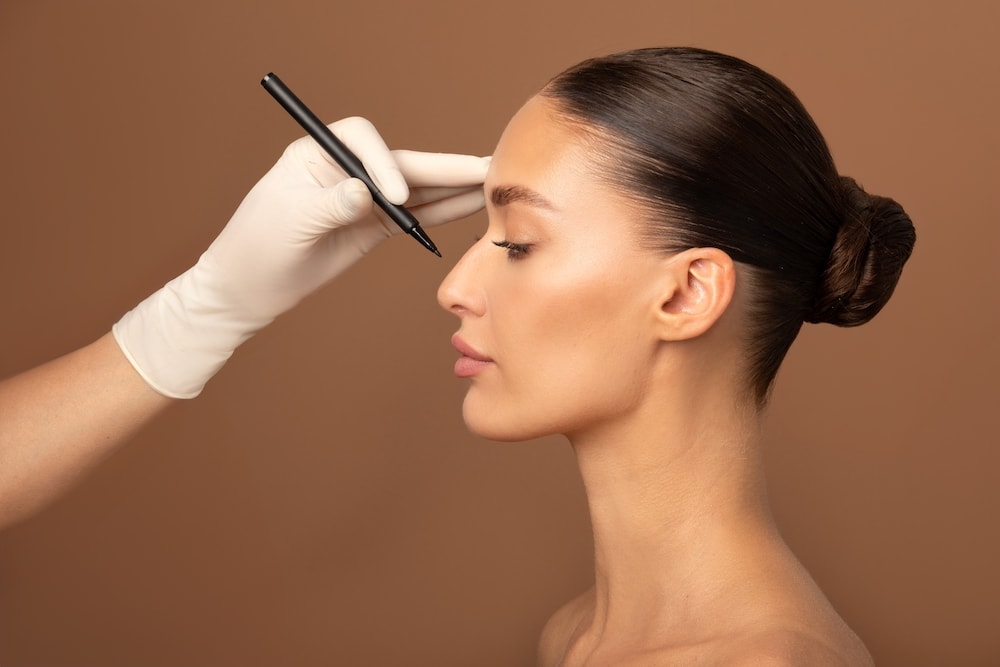
Achieving the right projection and rotation of the nasal tip is one of the most complex and critical parts of rhinoplasty. Even small changes can significantly affect the shape of the nose and the overall facial balance. To help improve precision in this area, our board-certified plastic surgeon, Dr. Jon Kurkjian, has co-authored and published a new surgical technique in the Aesthetic Surgery Journal Open Forum, titled The Saddle Projection Graft.
Developed by Dr. Kurkjian, this technique introduces a new way to control nasal tip position using a small, carefully placed cartilage graft. Known as the saddle projection graft, the method is designed to provide better support, maintain long-term tip projection, and reduce some of the issues that can arise with older grafting techniques. The early results have been very encouraging in both first-time and revision rhinoplasty patients.
Why Tip Projection Is So Important
The position of the nasal tip plays a major role in how the nose looks from both the front and the side. If the tip doesn’t project far enough, the nose can appear too flat or undefined. If it projects too much, it can draw unwanted attention. The tip also affects the “supratip break,” which is a slight dip above the tip that helps create a smooth, elegant contour in the lower third of the nose.
Keeping the nasal tip in the right position over time can be tricky. After surgery, the nose continues to heal and change, and scar tissue can subtly pull on the tissues, causing the tip to shift or lose definition. That’s where the saddle projection graft comes in—it’s designed to resist these forces and help the nose keep its intended shape.
What Is the Saddle Projection Graft?
This technique uses a small piece of cartilage, usually from the patient’s own nasal septum, that is about 5 by 15 mm in size. The cartilage is shaped with a small groove (or “saddle”) down the center. This groove allows the graft to fit snugly over a specific area of the septum (called the anterior septal angle), which serves as the base.
Once positioned, the graft is secured with tiny sutures to keep it stable and prevent it from shifting or rotating. The nasal tip is then supported on top of this structure, giving the surgeon greater control over how far it projects and how much it rotates.
One major benefit of this approach is that it doesn’t require a lot of cartilage, which is particularly helpful in revision cases where the cartilage supply may already be limited. Because the graft sits in the midline, it also helps reduce the risk of asymmetry or unwanted deviation.
How Is It Different from Traditional Methods?
There are several established techniques for supporting the nasal tip, such as columellar struts and septal extension grafts. While these methods can work well, they each have some limitations. For example:
- Columellar struts may not provide enough projection and often require rib cartilage for length.
- Some septal grafts can make the nose look bulky or cause issues with nasal airflow.
- Others demand large amounts of cartilage or can be difficult to stabilize.
The saddle projection graft was developed to solve many of these problems. It:
- Maintains a central (midline) position to promote symmetry.
- Avoids adding bulk or causing breathing issues.
- Uses a small, sturdy piece of cartilage.
- Provides a stable “cartilage-on-cartilage” interface to resist shifting over time.
- Reduces the need for overcorrecting the tip in anticipation of scar-related changes.
Because the graft’s strength comes from how it’s secured directly to the septum, the final result tends to be more predictable—something both surgeons and patients can appreciate.
A New Tool in Precision Rhinoplasty
For patients considering rhinoplasty—especially those looking for subtle, refined changes or revision surgery—the saddle projection graft offers a new layer of precision. While it’s a technically advanced procedure, the goal is simple: to deliver a more stable, natural-looking nasal tip that holds its shape beautifully over time.
Dr. Kurkjian remains committed to surgical innovation, and his latest publication reflects his passion for achieving the best possible outcomes for his patients.
You can read the full article and watch the accompanying video in the Aesthetic Surgery Journal Open Forum here: The Saddle Projection Graft.